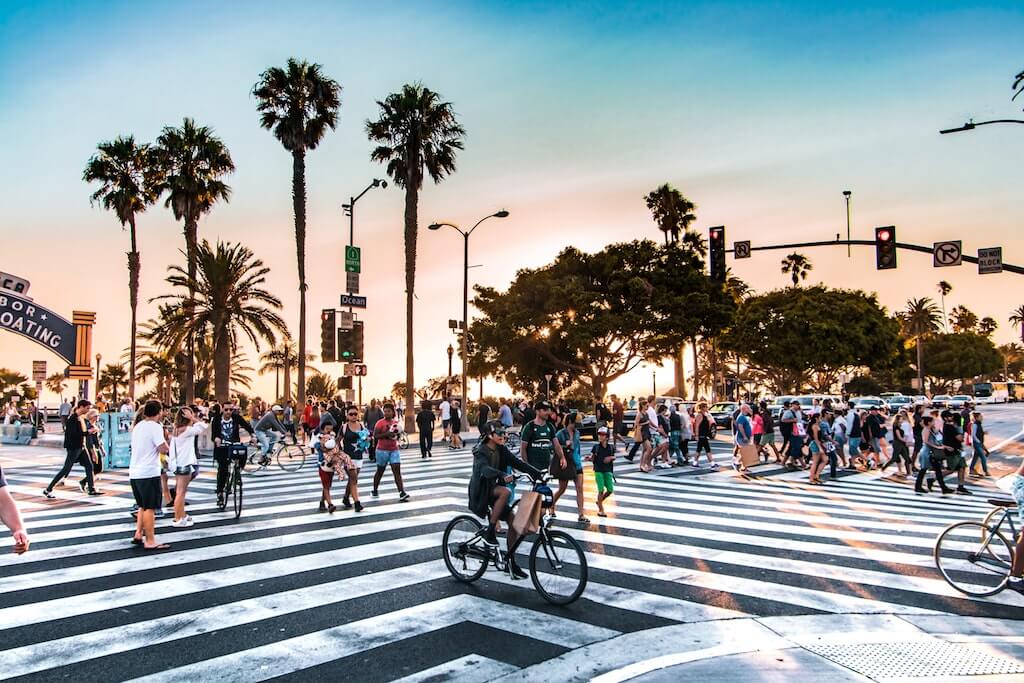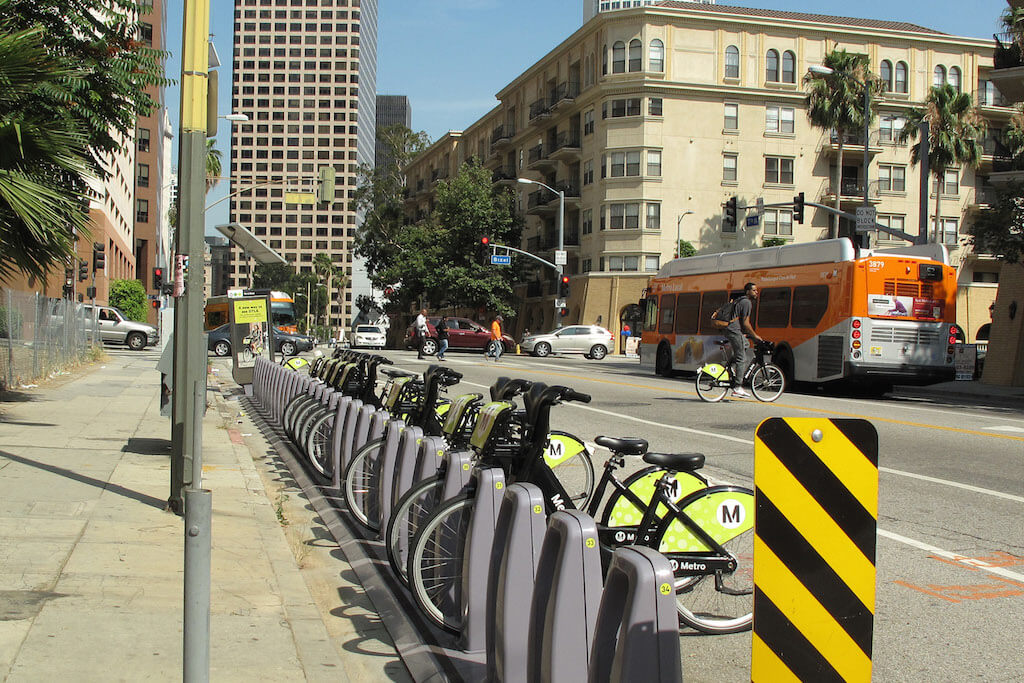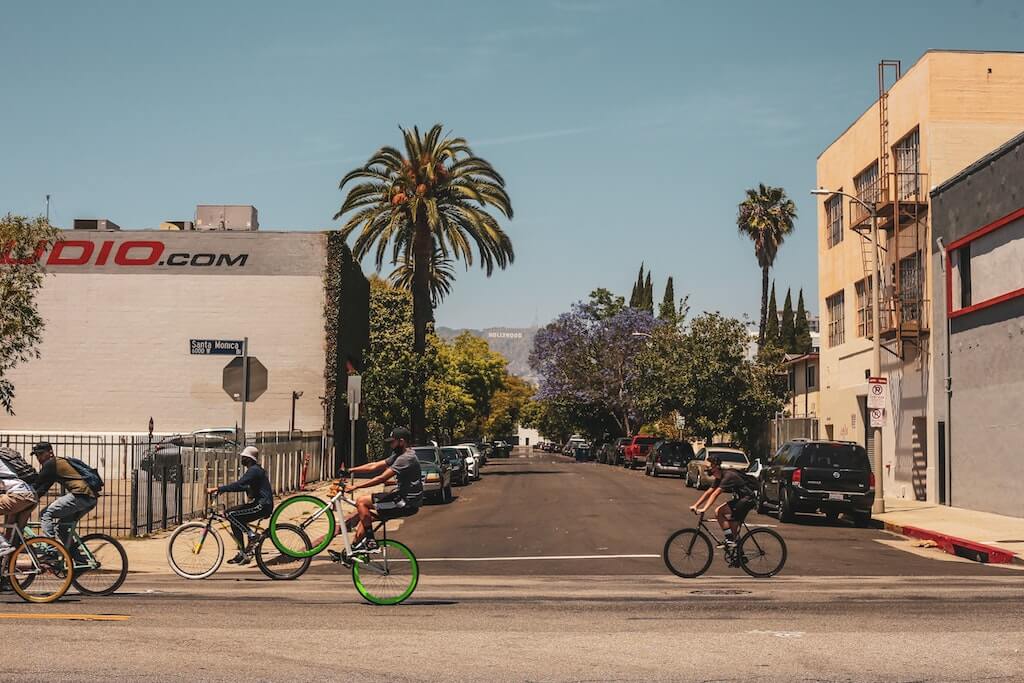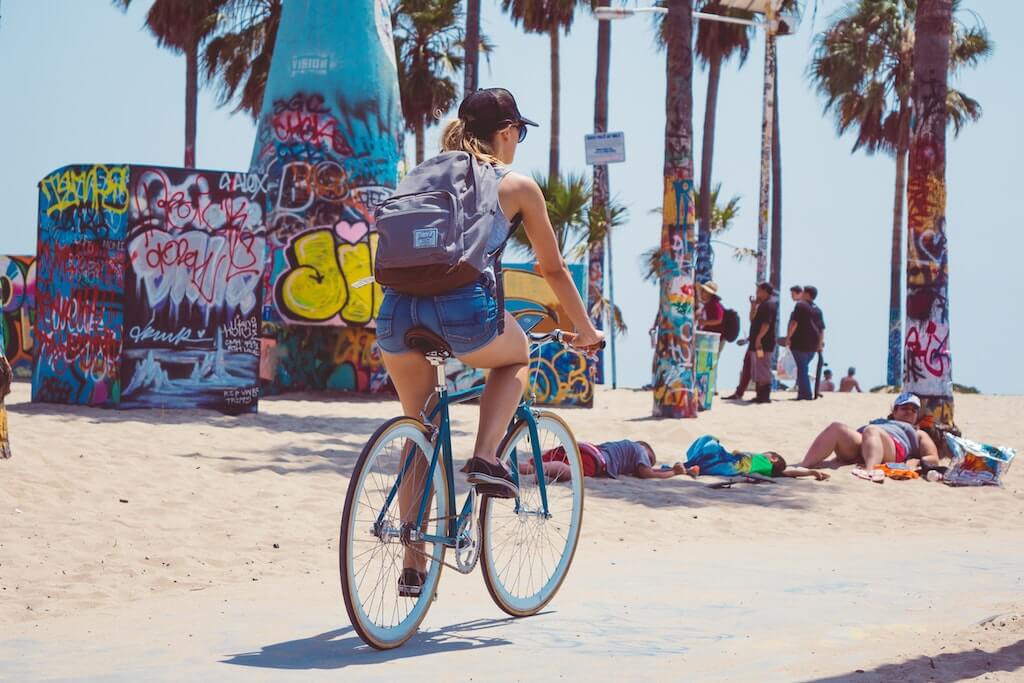Autumn Gear Guide
Find inspiration in our Gear Guide that will keep you out on your bike through wind or rain.
Download NowHere are two phrases that don’t often go together: “Los Angeles” and “bicycles.” At least, that’s the popular opinion. And if you base your judgments on headlines alone, riding a bike in L.A. does sound insane. Take a 2018 article in Bicycling Magazine: “Los Angeles is the Worst Bike City in America.” Or a 2019 […]

Here are two phrases that don’t often go together: “Los Angeles” and “bicycles.”
At least, that’s the popular opinion. And if you base your judgments on headlines alone, riding a bike in L.A. does sound insane.
Take a 2018 article in Bicycling Magazine: “Los Angeles is the Worst Bike City in America.”
Or a 2019 article in U.S. News & World Report: “Why Is Los Angeles So Dangerous for Cyclists?”
Or a 2021 Guardian article: “‘Bike Lanes to nowhere’: for cyclists, Los Angeles is heaven and hell.”
Or… you get the idea.
Then come the statistics: 2,528 bicycle accidents across Los Angeles County in 2020, leading to 23 deaths, according to personal injury attorneys Maison Law. Sixteen “bike stops” that resulted in shootings by police, 11 of which were fatal, according to the Los Angeles Times. Or a heartening report from Crosstown, that “only” 2,011 L.A. bicycles were reported stolen in 2020, which was down from the previous year, at 2,412.
Truly, no one will confuse biking around L.A. with biking around Copenhagen. Any city famous for its high-speed chases — where live news coverage from helicopters is treated as daily entertainment — is probably not ideal for pedaling to the bodega for milk. Los Angeles is built around cars. Highways dominate the landscape. The second question you’re asked when meeting someone new, is “What do you drive?” Why shouldn’t L.A. be awful for bikes?
But is L.A. really that bad? In a nation as hostile to bicycles as the U.S., why does the City of Angels stand out? And how are advocates changing the landscape, in ways that outsiders might not realize?
Adam Greenman had visited L.A. before. But for their anniversary last August, Greenman and his wife wanted to try something new: They would tour the city by ebike.
“We wanted to go somewhere warm and far,” says Greenman, who works as CEO of the Jewish Alliance of Greater Rhode Island. “I had been there twice before, but never biked there.”
Greenman was no naïf. He had biked in dense East Coast cities like Philadelphia, Washington, D.C., and Montreal. He knew L.A.’s reputation for dangerous cycling, and he didn’t want to ride a long distance if it meant sweat and exhaustion. But the idea of an ebike tour enticed him. And that decision would have life-changing effects.
Everything went right. Because they picked a weekday — and likely because of COVID — Greenman and his wife were the only ones to sign up for that day’s tour. The weather hovered around 80 degrees F., and the sky was typically sunny. They rode their ebikes 36 miles through the valley, with stops in West Hollywood, Culver City, and the Santa Monica Pier. Much of the journey took place on quiet side streets and smooth bike paths.
“The trails were terrific,” recalls Greenman. “Because of the size of L.A., they went on for miles. One was down by the L.A. River, which was just this majestic part of the city that we had never thought about. The infrastructure was well maintained. You could tell that there were people who really used these trails to get from A to B in a safe way.”
Greenman did notice plenty of weaknesses, of course. The route felt “disjointed,” with a mix of paths, bike lanes, and busy avenues. Some multi-lane roads didn’t have so much as a shoulder to ride in. “Some places were better than others,” he says. “There were definitely a couple of hairy moments. But even in places where I felt a little unsafe, it wasn’t too bad.”
The tour itself wasn’t as important as what happened after the tour: Greenman decided to buy an ebike. He now commutes regularly to work in Providence, cycling five miles between home and office. Each way takes about 18 minutes to pedal; when traffic is slow, driving a car can take more than 20 minutes.
“I came back and did some really heavy research on different commuter e-bikes,” says Greenman. “There are days where I have to dress up. I really wanted to make sure I could ride my bike and still accomplish that. The trip in L.A. convinced me that that was possible.”
“L.A. should be a bicycle mecca,” says Eli Kaufman, executive director of the Los Angeles County Bicycle Coalition (LACBC). “Los Angeles enjoys some of the greatest weather in the world. The vast majority of Angelinos live and work in the flats. We’re a culture that cares about our fitness and our health. We have all the elements to be a great bicycling region.”

Just as Greenman found, L.A. is crisscrossed with several paved bike paths, such as the 28-mile-long San Gabriel River bike trail. Cyclists can spend all day cruising the Pacific oceanfront, from Redondo to Palisades Park, and find limitless entertainment along the way. You can easily rent from Metro Bike Share, which has dozens of stations across the city, and units cost only $1.75 per 30 minutes of use. Meanwhile, the basin is shockingly level; you can ride huge swathes of Los Angeles without climbing a serious hill.
Indeed, Los Angeles has a rich history of outdoors activities, including cycling. The origins of BMX bikes can be clearly traced to Southern California. The dynamic hills that cradle Los Angeles have drawn mountain bikers for decades. Some urban riders even embrace the thrill of high-speed traffic, as portrayed in the 2010 documentary To Live and Ride in L.A.
But daredevilry isn’t for everyone. An increasing number of Angelinos just want to move around by bike and not get killed doing it. The LACBC was founded in 1998 to advocate for cyclists’ rights, and the organization has grown incrementally since.
A major hurdle is cultural: Cycling has long been perceived as sport and exercise, but little else.
“It’s always a bunch of Spandex-riders on really expensive bikes – that’s what [Angelinos] think of when they think of bikes,” says Kevin Shin, deputy director of the LACBC. “There’s a caricature of cyclists that has been created for drivers.”
Shin grew up in Los Angeles, but he lived for several years in both Washington, D.C. and Boston, Massachusetts. As time passed, Shin and his wife dropped their second car, then replaced most of their driving with bikes and subway rides. When Shin relocated to Long Beach, he decided to sustain his cycling lifestyle, and he sought other Angelinos with the same preference.

What Shin discovered was a sizable population that relied on bicycles to get around. The reasons for this necessity are diverse: poverty, immigration status, revoked licenses, disability, and so on. Shin describes this as an “invisible population,” which he estimates in the tens of thousands. “It’s a lot more than people realize,” he says.
In many ways, Los Angeles is a victim of its own frenetic history. The sleepy valley rapidly urbanized in the 1920s, just as the Model T Ford took over American roads. A comprehensive trolley system, known as the “Red Car,” was one of the more famous casualties of the interstate highway system. Since then, Los Angeles has become synonymous with luxury vehicles and never-ending strip malls. According to Kaufman, the average car trip in Los Angeles is between three and five miles.
“The car has been perfectly marketed here,” says Kaufman. “We have sprawled to the very limits of our ability to transport ourselves. But the car doesn’t play well with transit. The car is the least-social vehicle that was ever invented. We haven’t created the space for people to ride bikes.”
“We’re not unrealistic,” he adds. “We’re not saying ‘go-car-free.’ Just go car-light.”
The city is also challenged by its sheer size; L.A. isn’t a city so much as a patchwork of smaller cities, each with its own rhythm, reputation, and local government. To an outsider, Compton and Pasadena are both “Los Angeles,” but they are technically separate cities with wildly different personas. A question as simple as “can you ride on the sidewalk” merits many different answers, depending on where you are. In some parts of L.A., riders are encouraged to ride on sidewalks, which are often wide and empty; in others, you can’t.
“City by city, we have different ordinances,” says Kaufman. “In some cities, it’s illegal, and you will get ticketed. I would be wary of that.”
When Shin became involved in cycling advocacy, he was drawn to equity and inclusion. Social contrasts are visible everywhere in the U.S., but they are particularly stark in L.A., where the millionaire celebrities of Beverly Hills live a 30-minute drive away from the tent cities of Skid Row. L.A. has a long history of racial tensions, especially between police and people of color, and everyday encounters often end in violence.
One solution was simple but effective: handing out electric lights. The LACBC kicked off Operation Firefly in 2016, and the organization has handed out more than 16,000 bike lamps.
“Folks were getting stopped for not having sufficient lighting for the legal requirements for riding at night,” says Shin. “When you have an interaction with law enforcement, it often doesn’t go well. So we thought, let’s just take it one step further and give people lights for their bikes. You want people to be seen.”
Operation Firefly served a double purpose: The LACBC could also survey cyclists from that “invisible population” about their bicycle usage. Such data are vital in a city as diverse as L.A., where homelessness and language barriers are everyday hurdles.
The LACBC has innovated other solutions as well. To help broaden access during COVID, they started a Bike Match program, which puts bikes in the hands of low-income commuters. The “Bikes Mean Business” campaign was designed to encourage both cycling and the patronage of small enterprises, which were hit hardest during the pandemic.
One of the best-publicized concepts is Sunset4All, a protected bidirectional bike lane that would run 3.2 miles along Sunset Boulevard. Sunset4All is an independent project, but organizers have partnered with the LACBC.
Still, is all this creativity enough to turn the tide of SoCal culture? After a century of motor-centric development, what will it take for L.A. to see meaningful change?

On paper, Los Angeles is already on the road to a better future. In 2013, the City Council ratified Mobility Plan 2035, a visionary redesign for urban transportation in Los Angeles County. The plan “provides the policy foundation for achieving a transportation system that balances the needs of all road users.”
But Kaufman claims that only three percent of that plan has actually been implemented. Separated bike lanes remain scattered and fail to connect.
“The problem in L.A. is that they’re bike lanes to nowhere,” says Kaufman. “They’ll dump you off into nothing.”
Meanwhile, institutional solutions are often murky. The city council is currently debating an ordinance prohibiting bike sales and repair in a “public right of way” (read: sidewalks). Supporters of the ordinance argue that cracking down on “bicycle chop shops” will reduce bike theft, a widespread local problem. Opponents see the ordinance as an unnecessary attack on the city’s massive homeless population; many Angelinos fix up bikes and sell them as a means of survival, and sidewalks are where they live.
“This is a band-aid solution,” says Shin. “This isn’t the core issue. Income inequality has taken such a huge toll. To target [homeless people] for doing something dangerous or problematic doesn’t get at the heart of the problem. It’s gonna create a tense situation that might result in the death of homeless folks.”
In such a conflicted megalopolis, it’s hard to imagine what a better version might look like. But not impossible.
Los Angeles is also home to CicLAvia, a recurring celebration of active transport and public spaces. Streets are shut down to motorists and fill up with cyclists and pedestrians. The CicLAvia nonprofit claims that 1.8 million people have participated in events since itfounding in 2010. In total, CicLAvia has provided 240 miles of “open streets.” Remarkably, the festival takes its inspiration from the celebrated ciclavía cycling network through Bogotá, Colombia.
“Bike culture comes out when CicLAvia happens,” says Kaufman. “That’s probably the cultural high point for cycling.”
But the carbon-neutral good times are short-lived. At the end of the day, the cyclists disband, and motorists are allowed to return to the pavement. Everything returns to normal.
“The tidal wave of cars floods the street again,” says Kaufman. “All the noise pollution and the fumes come back. It highlights how bad it is the rest of the year.
“But I do believe that we’re on the right side of history,” he adds. “There will be a tipping point. As we like to say, ‘There will be no peace in the street until all modalities have a piece of the street.’”
Find inspiration in our Gear Guide that will keep you out on your bike through wind or rain.
Download Now
Leave a comment